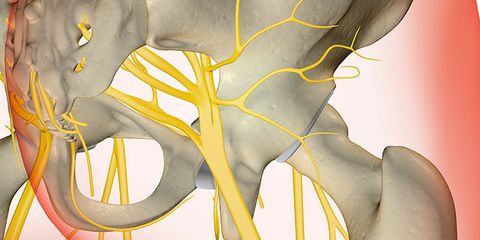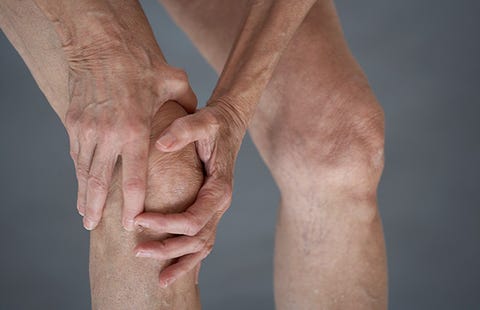How To Get Relief From Sciatica

MedicalRF.com/getty images
Pain that radiates down the back of your leg, numbness or tingling that extends down to your foot, a quick jolt each time you cough or sneeze—sounds like sciatic nerve pain, right?
Well, maybe. For one thing, "sciatica" is actually a symptom, not a condition. It's leg pain (anywhere from the lower hip and butt region, all the way down to your toes) resulting from a pinched nerve—most likely because of a herniated or slipped disc. Contrary to popular belief, actual back pain doesn't usually come along with sciatica—or it's a minor part of the overall problem. "If a patient has 80% leg pain and minimal back pain, it really turns on our radar for sciatica," says Eric Mayer, MD, sports and spine specialist at Cleveland Clinic's Center for Spine Health.
(Want to get in shape but don't have time for the gym? Then try Fit in 10, Prevention's super-effective workout program that only takes 10 minutes a day!)

PASIEKA/SPL/getty images
How do you know for sure that shooting pain is nerve-related and not coming from somewhere else—like your muscles? Here are tips on getting to the root of your agony, once and for all.
1. You feel weak in your knees.
Well, actually just one knee—and it runs throughout the entire leg. The sciatic nerve—the one that gets pinched and causes sciatica—is the largest single nerve in the entire body, running from the lower spine all the way down to the foot. When that nerve is pinched, its function is disrupted, resulting in all kinds of unwanted sensations, such as pain, weakness, and tingling. And while pain is pretty common (and oftentimes hard to diagnose), pain and weakness in a single leg acts like a red flag for doctors. "Patients often drive to the emergency room for pain, but it's really the weakness that's concerning—if you see that you're getting weak, you should seek care," says Mayer.

Nisian Hughes/getty images
MORE: 11 Highly Effective Solutions For Sciatica
2. You're a walker, not a runner.
If you're not training for your next marathon or logging hours on the treadmill, there's a good chance your leg pain is sciatica caused by a herniated disc, not the less-common piriformis syndrome, which mainly affects athletes. The funny thing is that piriformis syndrome presents itself almost exactly like sciatica: pain, tingling, numbness starting in the buttocks and extending down the leg. But instead of a slipped disc causing the issues, your piriformis muscle (found in the butt near the top of your hip joint) is pressing on that touchy nerve.
3. You can't summon your pain (not that you'd want to).
Telling a doctor you have "pain" is kind of like going to Ben & Jerry's and ordering "ice cream"—specificity is key. Sometimes the pain you think is sciatica isn't actually nerve-induced pain at all, but rather, something muscular. So how do you find out? Use your thumb, suggests Jacob Teitelbaum, MD, author of Real Cause, Real Cure. "Push around on the muscles in your lower back and see if you can find spots that affect your pain," says Teitelbaum. If you can trigger pain by a push—not a gentle push, you want to exert at least 5 to 10 pounds of pressure—your pain is most likely muscular and the result of a shortened, tightened muscle. "When a muscle gets stuck in the shortened position, it gets thicker and doesn't get the blood or nutrients that it needs," says Teitelbaum. And when you press on those tightened muscles—especially on the small, tender knot in the center—it can send pain throughout the body.

Hero Images/Getty Images
MORE: 7 Weird Reasons You're Gaining Weight
4. There's one test you just can't pass.
It's the main test docs use to diagnose sciatica caused by a slipped disc, and it starts with you lying down with your feet stretched out. The examiner then raises your straight leg between 30 and 70 degrees. Pain from this test—the kind that radiates down your entire leg, below your knee, and possibly even down to your toes—indicates sciatica. This is because when you stretch the affected leg, you're also stretching the entire sciatic nerve, and if the nerve root is pinched, you'll feel it through the stretching movement.
5. You've gotta go a whole lot more.
We're not talking about getting up a few extra times each night, but rather, totally losing control of your bowel and bladder movements. When paired with the typical sciatica pain, doctors treat this as a "surgical emergency," according to Alan Hilibrand, MD, spokesperson for the American Academy of Orthopaedic Surgeons. It's extremely rare, but if the spinal column is putting that much pressure on the nerve, it can lead to permanent damage to bowel and bladder function, so be sure to see a doctor immediately.
But here's the good news: Most of the time—like 80% of the time, according to Hilibrand—sciatica will clear up on its own (exactly how is another story—docs can't agree on whether the disc moves itself back in place or if the nerve simply stops being bothered by it). "The majority of people who have an acute event of sciatica will gradually improve or resolve in about 90 days," says Mayer. During that time, it's best to make the sciatica manageable through pain medication, anti-inflammatories, or physical therapy; your doctor may even suggest an epidural steroid if over-the-counter meds aren't doing the trick. But if symptoms persist past the 3-month mark, surgery may be your best option.
Amber Brenza Amber Brenza is the health editor at Women's Health, and she oversees the website's health and weight loss verticals.
This content is created and maintained by a third party, and imported onto this page to help users provide their email addresses. You may be able to find more information about this and similar content at piano.io
How To Get Relief From Sciatica
Source: https://www.prevention.com/health/a20483872/sciatica-symptoms/
Posted by: sharpslosicessir.blogspot.com

0 Response to "How To Get Relief From Sciatica"
Post a Comment